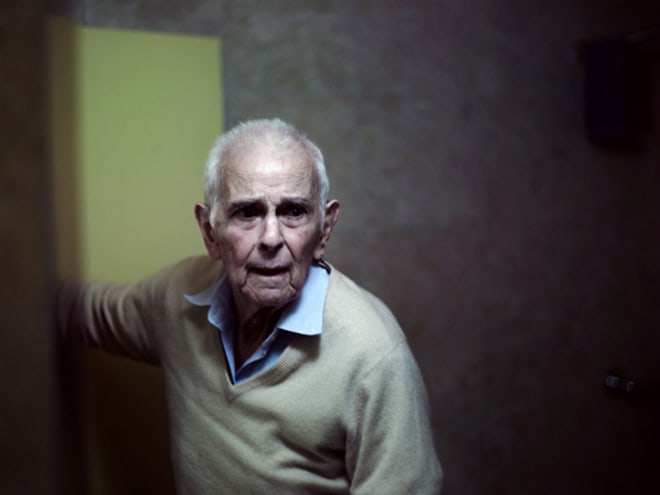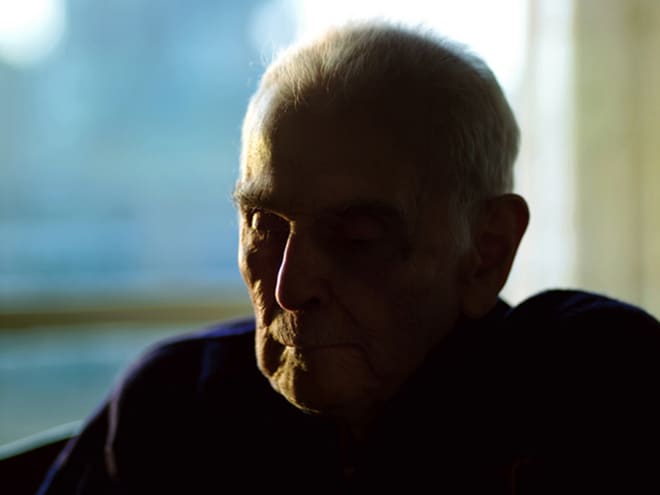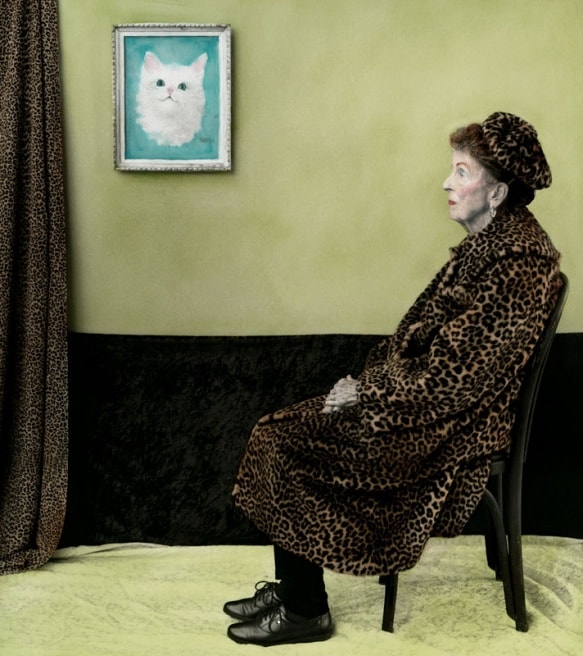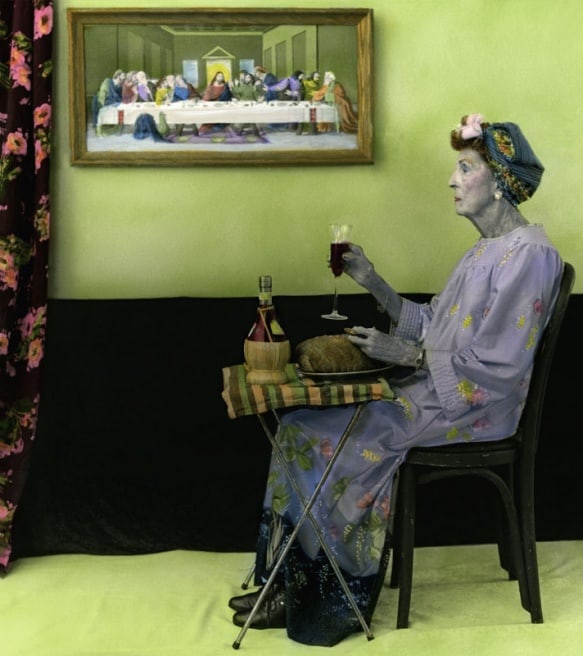In this essay, I explore the representation of ageing in contemporary documentary projects and discuss projects that mix documentary and fictional approaches.
In contemporary documentary photography one can observe a variety of images depicting elderly people, their daily lives, their habits, attitude towards life, and relationships.
It is clear that this “intimacy,” so much because of Nan Goldin, is widely accepted as we move further into the twenty-first century. There are a many projects showing people during personal intimate daily activities, where, for instance, they are naked or half-naked, showing their bodies in detail. At the same time, when elderly people are depicted (half) naked, the image seems unacceptable and provocative. When these images are shown, the viewer may feel the artist is ridiculing his or her models (only by the mere fact of showing such images, regardless of the way he/she photographed them).
Because we are conditioned by seeing glamorous, glossy young faces and bodies (youth ideology), we are more reluctant to look at depictions beyond it. Even some elderly people themselves are convinced that old age makes them not worth to be photographed, which may be illustrated by a phrase said by an elderly woman during the shooting of “Zapis Socjologiczny” (A Sociological Record) by Polish photographer Zofia Rydet.
The woman tried to refuse to be photographed by saying: “I am so frumpy, old, nasty, why are you doing this?”1.
Often when photographers create stories about their elderly relatives, they depict very simple, intimate moments from a daily routine. It is important to note that the photographers, being a relative, are “insiders,” able to observe the very intimacy of the daily-lives of their models, which is absolutely impossible for a stranger.
The topic of ageing and death
First of all, let us discuss why the topic of “ageing” (and death) is so crucial for photography today.
From the 1970s death became a legitimate subject for photographers whose outlet was the exhibition gallery or the published monograph. For the first time on any significant scale, art photographers in the West began to focus on death. There were many factors influencing this significant shift in attitude. In the urban and industrialized areas of the Western world most of us had relatively little first-hand experience with death…. 2.
Death as a phenomenon disappeared from daily life in the Western world; dying people were displaced into hospitals and hospices, the deceased were hidden in morgues, and cemeteries were moved outside of cities. Linkman mentions in the book Awareness of Dying 3, it is crucial for there to be an alteration of the attitude to death in society. The authors encouraged doctors in America to break from their rule of silence and inform patients if they are dying, suggesting that the patients make their last end-of-life choices. Within this context, photography becomes a tool for relatives (or even the suffering themselves) to depict those days via camera and, therefore, save the memories about him/her.
Documentary projects which deal with this topic often have the same structure irrespective of the reason of approaching death (be it cancer, AIDS, or ageing). The plot of such projects consists of a depiction of monotonous, event-free, everyday life. Indeed, the central drama here is a life that fades away. Photographers initiate a visual discussion about identity and sexuality change, decay, and individual dramatic confrontation with mortality.
Projects on Aging and Dying
Projects around ageing and dying relatives can be created in a classical documentary style (Philip Toledano, Daniela Kapralova), in a genre of art-photography (Vesselina Nikolaeva), include elements of staging and theater (Aline Smithson), as well as be an entire reconstruction of the real story (Dru Donovan).
I will now focus on two projects which, in my opinion, constitute the two main approaches to ageing representation – the classic documentary and conceptual.
A son’s photo diary, Days with my father by Philip Toledano, tells a story about his ageing father’s last years and the relationship between the father and the son. After the death of his wife, Philip’s father lost his short-term memory. He could not accept her death and, therefore, his memory extruded this information. Philip started a blog in which he posted photographs and accompanying reflections on his father’s changing state. During three years until his death, Philip took and posted everyday life pictures of his father.
An opening photo in the project shows an elderly man sleeping in a chair with a funny sleeping-mask on (a mask with closed eyes embroidered). He looks touching and helpless. This sleeping mask connotes a return to childhood; people of an older age become childlike (they demand care, help and attention). Despite the very realistic way of shooting, which shows us the change of skin texture with age, corporality is not shown as repulsive. Rather the viewer’s attention is drawn to the character’s fragility and vulnerability, as he is a weak and a feeble man, in need of care and protection.
In Toledano’s diary, which serves as a project’s description, he describes how he attempts to protect his father from the external world by creating an artificial one, with nothing bad and dreadful. The son aims to create a secure, childhood-like world.
In this project, there are many close-up portraits of the father. A viewer may approach the character from very close, from an “intimate” distance 4. The viewer (or reader of the visual text) is, thus, involved in what is happening, not as an observer but as a participant. With certain portraits, the father looks directly at the viewer, into his or her eyes. That kind of contact (eye-to-eye) of a viewer and a depicted person is defined as “demand” 5. That is the demand of attention, participation, and a direct challenge from a depicted person, fully aware (s)he is being photographed. (S)he directly communicates with a viewer, who is forced to interact.
The sequence of Philip Toledano’s photographs does not have a classic plot (rising action, climax, falling). The narration is straight forward-a viewer follows the daily life of an elderly man through his portraits and fragments of his environment. There is no evident collision. The character remains in the same place, in his room, and the environment does not change; it is only his emotions that change.
It is the permanently oppressive anticipation of the end that builds a plot of the project – every day for the son (and every next photo for a viewer) turns into a painful subconscious expectation ñ “When? What if this was the last one?” That painful, restless process turns into suspense for a viewer, involving him/ her in an endless state of anxious expectation of the inevitable.
After viewing the entire project, the title picture with the mask gains a new level of understanding. It becomes a metaphor of the father passing to another world, and represents sleep as death. But death also becomes a “departure to Paris” (according to the story Philip made up for his father, the mother “flew to Paris and is now taking care of her brother”). Toledano consciously chose this photo as an opening one- a man, sleeping in the chair resembles a plane passenger. “Now he’s gone to Paris to meet my mum” is the last note in the son’s diary, which concludes the story about his father.
In her photo project Arrangement in Green and Black, Aline Smithson photographed her 85-year-old mother. This project lies somewhere in the space found between documentary and conceptual photography. The compositional framework is mimicry of the painting Arrangement in Grey and Black: Portrait of the Artist’s Mother by a Victorian’s epoch painter James Whistler. For two years, Smithson was looking for and buying different clothes and framed pictures at eBay and charity shops. Using Whistler’s composition as a “modular grid,” Smithson filled her photos with different props, always ironically playing with styles.
In these portraits, the mother is a “signifier,” as a sign she refers to different epochs, events, or styles. A Japanese geisha, Elvis Presley, a disco-girl of the 80s, a clown, a bride, a ballet dancer, and even a prisoner- all these images resemble “fashion-looks” put on an elderly woman, which transform photos into pop-art works. Smithson also includes, in the composition of her photos, different paintings written in naive-art style – from badly made copies of world art masterpieces to nameless images of kittens, dogs, and horses.
As discussed above, the father of Philip Toledano is an active subject, who is often in a direct visual contact with a viewer; whereas, in the images by Aline Smithson, the mother is depicted half-faced, “offering” herself as an object to look at. The distance between a viewer and the elderly woman photographed is quite substantial and makes the image impersonal. A viewer is not involved into what is happening, (s)he is a detached observer of the “painting,” neither forced to empathise nor invited into the personal space.
That game with pop-culture and theatrical staging can be considered an attempt to “remove” or to “mask” the feeling of dying corporality, while bright colouring looks unnatural and is likely an endeavour to make something almost lifeless “alive.” This is supported by an emotionless, mask-like face of the woman, who looks aloof and indifferent to everything around her. From the project comments, it is clear that Smithson was trying to achieve this facial expression: “As a model she often wanted to be dramatic in the images, and I had to tone her down. She kept laughing as I was trying to focus and I had to tell her to stop smiling so much.”
Even though the photographs of Aline Smithson might look a kind of exploitation of her elderly mother’s appearance, as the mother does not completely understand how will she be depicted in the photos, one sentence from the text, written by her daughter, explains why an elderly woman readily participated in this photographic experiment: “As I progressed with the series, it become more meaningful, especially because I was bringing joy and laughter into our lives when there was plenty to cry about.”
It is obvious that a preparation to and shootings themselves became a new way of communication between the mother and her daughter. The mother took part in twenty shootings and passed away before seeing the result.
The two series analysed above represent a large group of projects where artists photograph their relatives (other examples are Sophie Calle’s “Rachel Monique,” Tierney Gearon’s “Mother’s Project,” Daniela Kapralova’s “Susanka’, Salva Lopez’s “Roig-26”, etc.). Each project is unique, with its own visual language and narrative. Nevertheless, most of them can be called “photo-therapy-like.” In psychotherapy, there exists a term “phototherapy,” which should not be mixed with a therapeutic photography.
Phototherapist Judy Weiser 6 explains that phototherapy is a therapy carried out by a doctor with the help of different photographs; whereas, therapeutic photography is done on one’s own in order to understand oneself, for personal growth and self-knowledge. It is evident that most authors apply therapeutic photography (or its elements) unconsciously. However, in almost every project text, it is clearly said that implementing photography helped authors to cope with the problems, which initiated these projects.
Such projects seldom depict evident process of ageing itself; rather, they touchingly represent sufferings of the person who struggles with age-related alterations and increasing weakness. A spectator cannot follow instantly noticeable age alterations in the character’s appearance. The character does not change much; (s)he is introduced to a viewer as an elderly person and fades away to the end. Ageing is interpreted here as the last period of life, not a phenomenon connected with the entire life-span (when a person can be repeatedly captured from birth to death, representing the flow of time).
Photography becomes not only memory-preserving, but also a means to “save” the disappearing matter in a digital/film form. It also provides a way to communicate with a dying relative, while other ways could have been lost already. Finally, it is a kind of a therapy for both a photographer and his/her elderly model.
This essay was originally published in Vasa Journal of Images and Culture.
Хитросплетение богемы и бизнеса (Paris Photo 2011)
November 30, 2011













